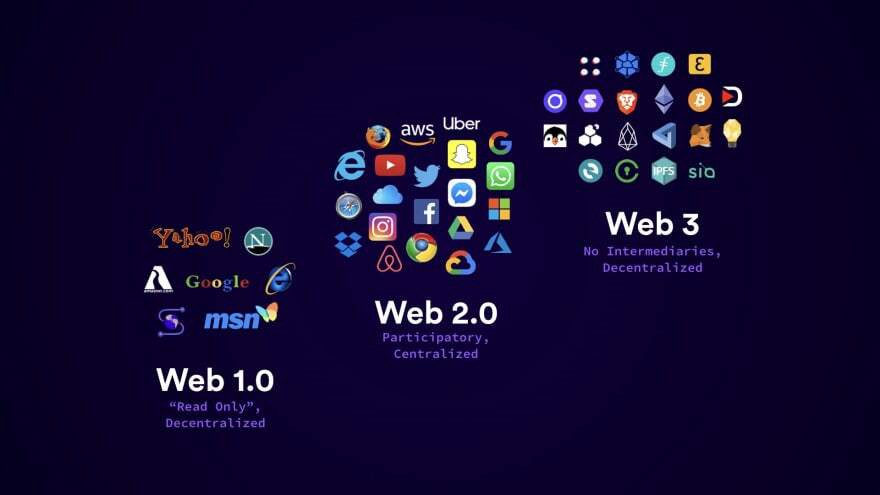Role Of Blockchain In Web3 World

Web 3.0 is the third generation of the internet that aims at promoting openness, privacy, and decentralization for a brighter and tech-driven future. The remarkable usability of this technology is designed to increase client loyalty and provide a better user experience. As Web 3.0 prepares to revolutionize how businesses operate and how internet users interact with the digital world there is little clarity on what it refers to. In this post, we will walk you through the origins of Web3 and the role of Blockchain technology in it.
Web 3.0 Beginnings
In 2014, Ethereum co-founder Gavin Wood coined the term "Web 3.0" while discussing the future of the Internet. Wood envisioned encryption technology being utilized to create secure internet environments that adhered to information privacy. After Edward Snowden, an American former computer intelligence consultant, highlighted the worries about government spying, Wood came up with a hypothesis. In this hypothesis, Wood said that Web 3.0 would allow everyone to access public information while keeping personal information private, which means an automated consensus engine would be preferred for the privacy processes.
However, there were no fast follow-ups on his Web 3.0 vision until 2021, when blockchain businesses began to reconsider Woods' hypothesis. Web 3.0 has been reinvented as a decentralized Internet network powered by blockchain technology.
The Web3 version of the internet will be no different in appearance from the Web2 for the users, only at the backend it will inter-chain different technologies with blockchain protocols.
What Is Web 2.0?
Web 2.0 is the current version of the internet that runs many of the networks ranging from online directories like Google, Yahoo, and Bing to creative social media platforms such as Facebook, Reddit, YouTube, and Twitter.
Web 2.0 was a technological revolution of the 2000s which transformed the web from static pages (web 1.0) to a dynamic version where users are allowed to generate content such as text, messages and videos and access it on the internet.
Difference Between Web 1.0 And Web 2.0
In the earliest stage of Web 1.0, content creators were limited and the majority of users were content consumers. The websites on the internet were static pages hosted on ISP-owned web servers. This has changed completely in Web 2.0, where the emphasis was on user-generated content, usability, and interoperability for end users all over the world.
- Web 1.0 - Read
- Web 2.0 - Read + Write
- Web3 3.0 - Read + Write + Own

Components Of Web 3.0
The framework for Web 3.0 has three essential Web 3.0 components for putting this system together. Here is everything you need to know about these components, namely - Blockchain, Artificial Intelligence (AI) & Machine Learning (ML), and Internet of Things (IoT).
Blockchain
Decentralization is a key component of Web 3.0 technology, and blockchain due to its decentralized nature, will help in building the network of Web 3.0.
Web 3.0 is expected to use a decentralized peer-to-peer file system that will allow user-controlled devices to power the Internet via a distributed node topology. It will reverse the current centralized mechanism and give the users sole ownership of their data.
Decentralized file storage systems are already being explored and developed by some Web 3.0 blockchain companies.
Decenternet on the other hand is a Web 3.0 browser developed by a Hong Kong-based firm. Their browser Osiris, a net-neutral browser, uses blockchain technology to provide a smooth and efficient Web 3.0 infrastructure and runs with quicker surfing speed, no annoying adverts, an in-built VPN, and does not trace user activities throughout the internet.
Artificial Intelligence (AI) & Machine Learning (ML):
Artificial Intelligence and Machine Learning are incorporated into the blockchain network to improve on-chain procedures and preserve data security.
These technologies are already in use by centralized internet companies for data analytics to populate users' online behavior for ad targeting. The AI system pulls out various pieces of information such as the device used by the user, their IP addresses, their location, the websites they frequently visit, etc.
On decentralized systems, Web3 blockchain networks will be able to implement enhanced security layers for personal data privacy. And also, these technologies will help detect potential weaknesses in a blockchain system which will increase trust and security.
Internet Of Things (IoT):
The Internet of Things (IoT) enables Internet-connected objects to operate on upgraded networks such as 5G which will improve interoperability. These devices can be used to send data to private blockchain networks, which provide tamper-proof records of shared transactions without the need for centralized control.
One such example of an IoT-based blockchain system is Helium which uses blockchain-based wireless internet infrastructure to connect low-power IoT gadgets like microchips and routers to the internet.
What Impact Will Web 3.0 Have On The Digital Era?
Web3 Advantages
- Anti Monopoly
- Data Privacy
- Data Security
- Ownership of data
- Interoperability
- Transparency
In addition to the above, Web 3.0 will open up new possibilities such as DApps (Decentralized Applications), Ethereum is currently the most popular platform for developing Web 3.0 DApps.. These dApps are hosted on the Ethereum blockchain by user-operated nodes, allowing anyone to access them without having to exploit user data.
Future Of Web 3.0
Web 3.0 is in its early stages of development. There are no defined definitions and methods particular to this technology, making it difficult for developers to comprehend and execute it. This transition will take time and it will be entirely dependent on how technologists advance it. Businesses, on the other hand, need to undergo a major revamp to survive this transformation and prepare for a brighter future.